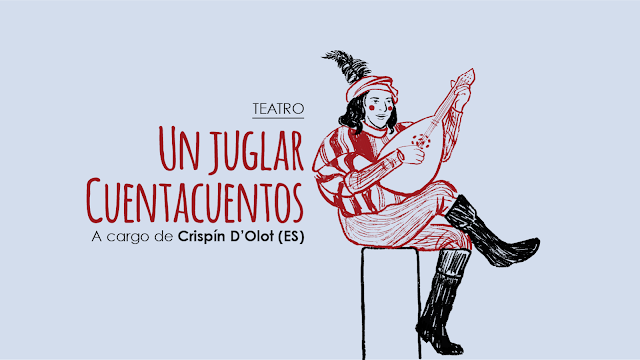INTERVIEW 24/08/2021
[Interwiew in Spanish/Entrevista en español]
If there is anyone in León who understands minstrels, it is Crispín d'Olot. Actor, musician, narrator and researcher, director of the Virtual Museum of the Juggler and the Musaescen project, participated this weekend in Sahagún in the XIX Encounter of Jugglers, a tribute to the art of entertaining, which this year included a series of lectures on the phenomenon of the minstrel, as well as street shows and a handicraft market.
Cristina Domínguez: This weekend the XIX Encounter of Jugglers was held in Sahagún, an event of great scenic load and medieval inspiration that wants to pay tribute to a guild and a way of entertaining that, they say, was born in the town of Cea in 1116. What is the basis for this statement? Was the first School of Jugglers born in Sahagún?
Crispín d’Olot: The deduction is made by Ramón Menéndez Pidal in ‘Poetry minstrels and minstrels’ based on the first Anonymous Chronicle of Sahagún. In 1116 there was a stable minstrel guild in Sahagún, an organized group of artists. Pidal deduces that, the existence of this guild would not be understood without a training center, schools of which it does have evidence in France; in Advent or Lent the lords would send the minstrels there to receive teachings. In short: such a statement is risky because there is no documentation that makes reference to a school of minstrels, but Sahagún is in a privileged situation within their history.
Question: What are we talking about when we talk about the minstrel? Were they more than just a synonym for entertainment?
Answer: The figure of the minstrel was born in the Middle Ages from the fusion of two artist. The entertainment part, the one most linked to the circus and humor, is inherited from the Roman "mime", a figure that was present until the fall of the empire and the formation of the Germanic kingdoms. The other half of the minstrel arrives with the Franks, Visigoths, Vandals… heroic songs and deeds and the rough music of their "bards" and "scops".
They provide us with the creation of epic poetry that will later serve as the unifying spirit of the European nations. It is very important because they are the first to perform in the language of the people and give a historical dimension to those kingdoms that are being formed and which will later become France, United Kingdom, Spain ... Along with entertainment, the minstrel becomes a transmitter of ideological content , primitive journalism.
Question: There is no data from the school, but documents have been found that speak, at least, of a Sahagunense minstrel ...
Answer: Indeed. There is a document of purchase of a farm, with a detailed location of the land - next to the church of San Cristóbal - in favor of a neighbor of Sahagún named Alfonso, a minstrel by profession. It is a document from the year 1111. Alfonso, ‘iugularem’, buys from Prior Martín a part of a hawthorn to make a garden, committing himself to deliver the tithe in garlic and onions. This document is in the National Library, together with the expulsion order issued by Doña Urraca.
Question: You mention that Sahagún is in a privileged situation in the history of the minstrel phenomenon in Europe. In your task as a researcher, have you found more references?
Answer: Many. In addition to the two documents that we have mentioned before, we see Sahagún in the Cantar del Mio Cid which, according to the latest research, could have been written by a minstrel. They tell us about Sahagún in the Song of the Siege of Zamora, in Galaicolusa poetry, in the Cantigas ... both in direct association and in sources Sahagún is a common reference.
Question: What do we owe to the minstrels?
Answer: It would be impossible to imagine Spain without the Cid, France without the Song of Roldan, England without the legends of King Arthur. All these literary works are minstrels' creation in part or totally and we owed them their dissemination. They are the first literary texts in the vernacular linked to a human group that will later be called a nation. Let us not forget that one of the distinctive features of the identity of a people or nation is the language. Well, the language that we speak today to a large extent is inaugurated and shaped by minstrels. And in that sense they are much more important than the troubadours, who do nothing but use that language when it has already been promoted by the minstrels' guild.
Question: Therefore, what role does Sahagún occupy in this cultural heritage?
Answer: It can be affirmed with Ramón Menéndez Pidal that Sahagún is one of the cradles of the Spanish language. Because, before it were written in the monasteries in the form of glosses, it was used by the minstrels in order to a poetic and ‘literary’ activity; I say literary in quotes because the letter is written. Perhaps the professor is exaggerating, but it must be taken into account that the minstrels were expelled in 1116, twenty-four years before the date proposed for the composition of the Cantar de Mío Cid. This would mean that the Spanish language would be highly evolved and, why not, Sahagún could have been a key linguistic laboratory in the modeling of the Cervantes language.




